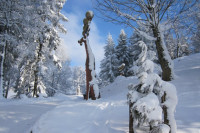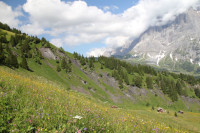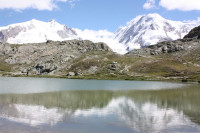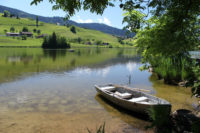Culture
The dark side of Chillon’s castle
A closer look at the history of the castle reveals a sad fate for its prisoners, either killed or left for years chained to pillars in the undergrounds.
Chillon: a beloved Swiss castle
The castle of Chillon, the most visited historical building in Switzerland, has drawn much interest since Lord Byron’s visit in 1816. Set in Veytaux, on the breathtaking lake of Geneva, known as the Swiss Riviera, people from all over the world have been rushing to see it. But looking back at its history reveals a darker past to which one cannot remain indifferent.
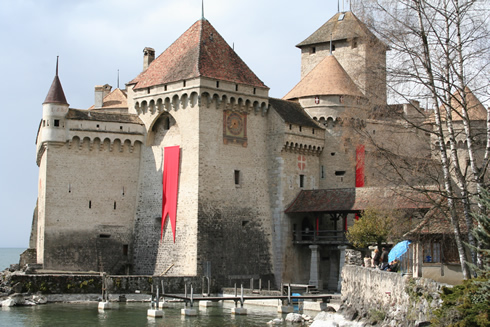
The entrance of Chillon’s castle – crédits Vivamost
Chillon from its beginning
- In 1150, the castle is mentioned for the first time, but its construction probably started much earlier according to archaeological finds. Its location was once very important, as it was built on a rock on the commercial road to Italy, going via the Alpine pass of the Grand-Saint-Bernard.
A medieval fortress, it later became a summer residence for the Counts of Savoy. Among other things, the Savoyards constructed new halls, courtyards, a chapel and a “camera domini”, the master bedroom of the dukes and counts. In the 13th century they built a prison in the undergrounds, which had previously been used to keep weapons and food.
In middle of the 15th century, the House of Savoy, controlling Chillon for four centuries, started having problems. Finally, during the war of Religions, the Bernese acquired the canton of Vaud and with it Chillon. From 1536 to 1798 the castle was under Bernese’s control. Unfortunately during that period many earthquakes and hurricanes damaged the old building. When left inhabited by the bailiffs, Chillon was used to keep prisoners and store weapons. The Bernese definitely left at the Vaudoise revolution.
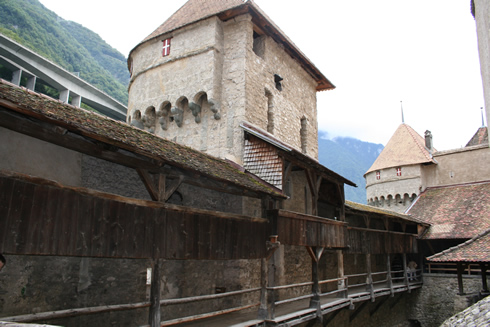
Top floor of Chillon’s castle – credits Vivamost
At the end of the 19th century, the association of Chillon’s foundation was created to preserve the monument. Renovations and archeological work followed, making it finally possible for the first visitors to arrive.
Chillon’s dark past
But what really happened in Chillon? Since the construction of its prison until 1861, many people were jailed there for various reasons. Some were locked in because of political or religious reasons while others were kept as war hostages. Many women, believed to be witches, were tortured and burnt at the end of the 16th century through the middle of the 17th century. It is also said that the chancellor of Savoy in 1455 was drowned in the lake after being questioned in Chillon.
The prisoners of Chillon
Who were the most famous prisoners? The capture and killing of Jews in the medieval Ages and the imprisonment of Bonnivard in the 16th century retained the most attention. The tragic treatment of the prisoners, including Bonnivard, has touched many artists over the years. Today, tour guides do their best to relate the horrible historical facts to the curious visitors.
The fate of the Villeneuve’s Jews
The 14th century was deadly for European Jews, especially in countries such as France, Germany and Switzerland. The plague killed many people on the European continent around 1348. As the population needed to blame the deaths on someone, people quickly blamed the Jews for wanting to kill the Christians. “The guilty of choice by excellence in such a situation, could not be anyone else than Jews,” writes Leon Alhadeff in Los Muestros. In the town of Villeneuve located around Chillon lived a group of Jews since 1284. Thomas of Savoy had founded the city in 1214 and Jews had come to settle there later.
It was incorrectly believed that the Villeneuve’s Jews were the cause of the Plague and its spreading across Europe. Rumors started; apparently, that they would have poisoned all wells and springs from Venice to Savoy causing the death of the people drinking the water.
The torture of the Jews
In September of 1348, all Jews there were arrested and sent to Chillon’s dungeons, at that time under the rule of Amédée VI of Savoy. According to Michael Freund in the Jerusalem Post, the rumors were the “groundwork for massacre and persecution” of the Villeneuve’s Jews. They were badly tortured in the torture chamber until someone talked. Promised forgiveness for their crimes, many admitted in front of a tribunal in the judgment hall, to have poisoned the wells and swore it on the Bible. In October, all Jews there, including children were decimated. Some committed suicide preferring immediate death to torture while others were massacred by the Villeneuve non-Jewish community.
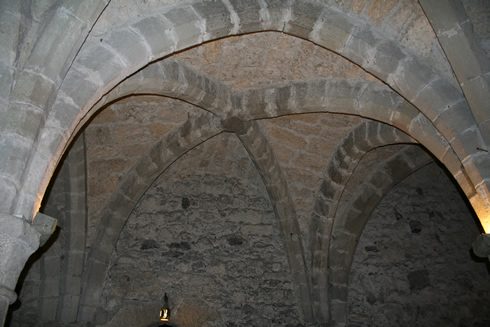
Chillon: ceiling vaults in the cellar where the jail was – credits Vivamost
The Association of Chillon’s foundation agrees that the prisoners were burnt “on the sides of the lake, without the army of the Count having done anything to stop it”. When the American writer, Harriet Beecher Stowe, visited Chillon, her guide compared those atrocities to the ones the Americans inflicted on the slaves.
François de Bonnivard
In addition to the Jews, François de Bonnivard (or Bonivard) was jailed there for six years. But who was he to “deserve” to stay for so long?
About Bonnivard
Bonnivard was a monk from the prior of Saint-Victor near Geneva. He was also a heretic, a friend of the Reform opposing both the Duke of Savoy, Charles III, and the Bishop of Geneva. Bonnivard was a well-known scholar and historian of his time.
After his release, he wrote a dictionary in French-German-Latin and a grammar book. Later, the republic of Geneva commissioned him to write the Geneva Chronicles. Captured in 1519 (till 1521), it did not stop him to continue fighting for what he believed in, liberty, and in 1530 he was taken captive again by the Duke of Savoy.
The first two years, Bonnivard spent them in a room while the last four he was chained at the fifth pillar third underground in the dark. “There are seven pillars of Gothic mould, In Chillon’s dungeons deep and old, There are seven columns, massy and grey,” said Byron. Around Bonnivard were six other cells, where prisoners were chained just like him. He was stuck on a three feet long chain and could only walk a few steps.
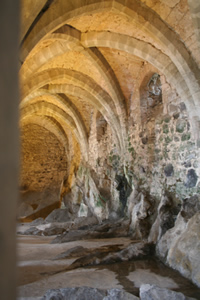
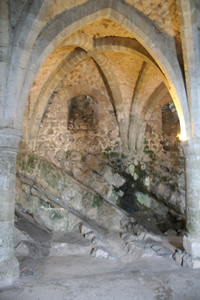
Bonnivard’s cell – credits Vivamost
The poets and Chillon
The French poet Victor Hugo left a detailed description of what he saw in Chillon. “He could only-lie on the rock- with a great deal of sorrows and without being able to spread his body parts.” Bonnivard was finally released in 1536 when the Bernese gained power over the House of Savoy.
Romantic poets started coming to Chillon beginning of the 19th century. The first one to visit the region and the castle was the Englishman Lord Byron.
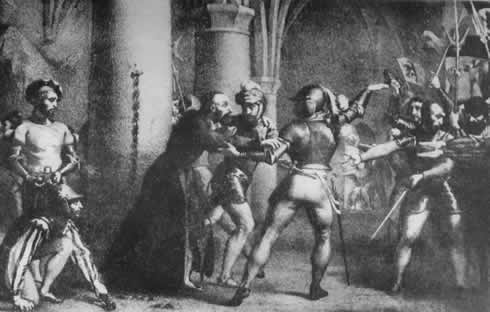
The delivrance of Bonnivard by Franck-Edouard Lossier in 1898
Accompanied by his friend, Shelley, another British poet, Byron asked permission to start archeological work. He believed the tomb of the Count of Savoy, Pierre II (nicknamed the “Small Charlemagne”), was under the chapel. Byron was never allowed to dig, but managed to carve his name on the third pillar of the underground.
After his visit to Chillon in June 1816, Lord Byron, inspired by what he had seen, wrote a long Sonnet about Bonnivard entitled the “Prisoner of Chillon.” The draft is said to have been made a few days after his visit and while still being in the Swiss town of Lausanne. Shelley writes about Chillon: “I have never seen a monument more frighteningly elevated by the insensible and inhuman tyranny which a man took delight in inflicting on a man.”

Montreux on the Swiss Riviera – credits Vivamost
It is thanks to Byron that Bonnivard and the castle of Chillon became known to the world. Many other famous poets and writers after Lord Byron continued showing interest, keeping the history alive. Painters such as Courbet, Delacroix, Brooke and Turner painted Bonnivard or the castle over and over again. Romanticized since the 19th century, Chillon has been attracting large crowds and probably will continue to do so for a long time to come.
You want to visit Chillon’s castle:
To visit Chillon, you can fly to Geneva and rent a car. It is 59 miles away. Located next to Montreux, famous for its yearly July jazz festival, it is a perfect day trip if you are touring the Swiss Riviera. You can also stop while driving from Geneva to Zurich. Just count a good 1h15 for your visit.
When you arrive, the castle will appear to you as a fortress, but on the lakeside, it looks like a princely residence. The view of the lake from the Banquet Hall is irresistible so don’t forget going on the little balcony there. If you are interested in medieval weapons and armors, you will enjoy the room of arms. In Bonnivard’s underground, Byron’s name is easily noticeable and covered by glass.

